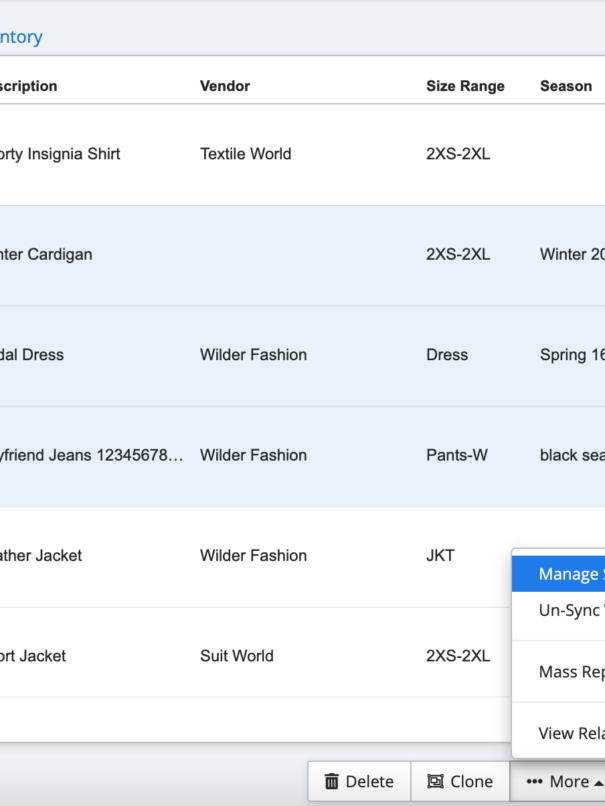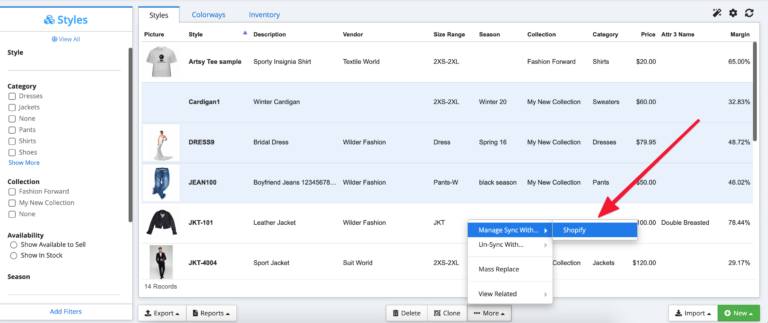Omnichannel approaches in the retail sector refer to the seamless integration of various shopping channels (like online, mobile, and physical stores). This approach aims to provide customers with a unified experience no matter how they choose to shop.
This strategy has become increasingly consistent and viable for the apparel industry. However, managing multiple channels all at once can pose quite a challenge. This is where modern solutions come into play. For instance, one of the most integral parts of this process is centralizing data and back-end tasks across all channels, and ERP, or enterprise resource planning, software does that with ease.
In apparel retail, ERP systems manage everything from product lifecycle and supply chain operations to customer interactions and sales data. This centralization is vital for retailers to provide a consistent and efficient customer experience across all channels.
Modern ERP systems are designed to be flexible and scalable, integrating easily with other technologies such as customer relationship management (CRM) and supply chain management (SCM), which are essential for a holistic omnichannel strategy.
The Evolution of Omnichannel Retailing in Apparel
The omnichannel approach when it comes to retailing marks a significant shift in the apparel industry.
In the past, retailers always started with just a brick-and-mortar store before expanding to telephone orders and then e-commerce. However, the market necessitates that all of these channels work seamlessly now.
Customers expect to interact with brands through multiple avenues — from checking product availability online to purchasing in-store, or vice versa. They also look for personalized interactions at every touchpoint, which requires retailers to understand their customers’ preferences and shopping habits across all channels.
And now, many wonder whether brick-and-mortar stores are future-proof or eCommerce will render them obsolete, but with the right strategy, brick-and-mortar stores can still be the main hubs for apparel brands.
Key Components of an Effective Omnichannel Retail ERP System
An effective omnichannel ERP system integrates various core components to manage and streamline operations across multiple channels.
These components include:
- Centralized data management: At the heart of an effective ERP system is its ability to centralize data from various departments such as sales, customer service, inventory, and financials. In a nutshell, ERP systems allow for all data to be consistent and accessible across the organization, allowing for real-time visibility and better decision-making.
- Real-time data access and analytics: A robust ERP system offers real-time data access, which is crucial for omnichannel operations where timely and accurate information is key to managing customer interactions across different channels. The system’s analytics capabilities enable businesses to derive insights from their data, enhancing decision-making and operational efficiency.
- Integration capabilities: Modern ERP systems are equipped with integration capabilities that allow them to connect seamlessly with other software solutions such as CRM, SCM, and e-commerce platforms. Some of the best ERP systems can even integrate with bookkeeping software and help businesses better manage their financial operations.
Advantages of Implementing Omnichannel ERP in Apparel Retail
Implementing an omnichannel ERP system in apparel retail brings several advantages:
- Enhanced customer experience: By providing a unified view of customer interactions across all channels, an ERP system helps create a personalized and consistent customer experience. Whether a customer shops online, via mobile, or in a physical store, the service they receive is unified and responsive.
- Improved inventory management: ERP systems enable better inventory management by providing accurate, real-time information about stock levels across all channels. This capability helps prevent stockouts and overstock situations, optimizing inventory levels based on actual demand patterns .
- Streamlined operations and increased efficiency: An omnichannel ERP system automates various operational processes such as order processing, fulfillment, and returns. This automation reduces the time and effort needed to manage these processes manually, thereby increasing efficiency and reducing the likelihood of errors.
Tackling the Rough Waters of Omnichannel ERP Implementation
Now, while omnichannel ERP solutions can help brands tremendously, the field isn’t without its whirlpools. One of the first big waves we have to ride is completely substituting those legacy systems. It’s usually not a straightforward situation; we’re talking major overhauls or even complete system replacements that are both pricey and complex.
Then there’s the beast of data silos. For smooth sailing, it’s critical that information flows freely across all departments and channels. This means breaking down those old barriers and syncing up data in real time to keep everyone on the same page.
And let’s not forget resistance to change. Many departments will just prefer the old way of working before getting accustomed to the new and better way of operating. The key to navigating this is clear communication, in-depth training, and getting everyone involved early on. This way, everyone feels part of the journey and is more likely to grab an oar and row with you, not against you.
Smooth sailing through these challenges involves mapping out a clear course with set goals and timelines, securing buy-in from all hands on deck early, and providing solid support along the way. This ensures everyone is ready to maximize the benefits of the new ERP system, making the transition as seamless as possible.
On the Horizon: Future Trends in Omnichannel ERP for Apparel Brands
On the tech front, we’re seeing some exciting trends that are really shaping the future of omnichannel ERPs in our industry. Artificial intelligence (AI) and machine learning (ML) are getting woven into the fabric of ERP systems, supercharging capabilities from forecasting and customer service to inventory management. These smart tools are getting better at predicting what customers want and when they want it, helping us keep our supply chains sharp and our customer interactions spot on.
The Internet of Things (IoT) is another trend that’s making waves, connecting just about everything in the retail space to gather and feed data back in real time. This tech is revolutionizing how we operate, making our processes slicker and our customer experiences smoother.
And let’s not forget about sustainability—a rising star on the consumer radar. We’re gearing up for future ERP systems that not only help us keep tabs on inventory and sales but also manage our environmental footprint. As we all aim for greener pastures, these tools will be vital in helping us navigate the sustainability landscape.
Looking ahead, the push for personalized experiences continues to steer the ship, driven by deeper insights from increasingly sophisticated ERP systems. The goal? To create a seamless integration across all platforms—ERP, CRM, SCM—you name it, making sure every customer interaction feels uniquely tailored.

Conclusion
The shift towards omnichannel retailing in the apparel industry highlights the critical role of advanced ERP systems in managing complex customer interactions and supply chain operations across multiple channels. The integration of ERP, CRM, and SCM systems facilitates a seamless and consistent customer experience, enhancing customer loyalty and satisfaction.
As retailers adapt to evolving consumer demands for personalized, omnichannel experiences, the importance of leveraging robust ERP systems equipped with AI, IoT, and machine learning capabilities cannot be overstated. These technologies not only streamline operations and improve inventory management but also play a crucial role in analyzing customer data to optimize marketing strategies and ensure service excellence in brick-and-mortar stores and online platforms alike.
Ultimately, the successful implementation of omnichannel strategies supported by sophisticated ERP systems positions apparel retailers to excel in a highly competitive market, ensuring they meet and exceed customer expectations in every interaction.









